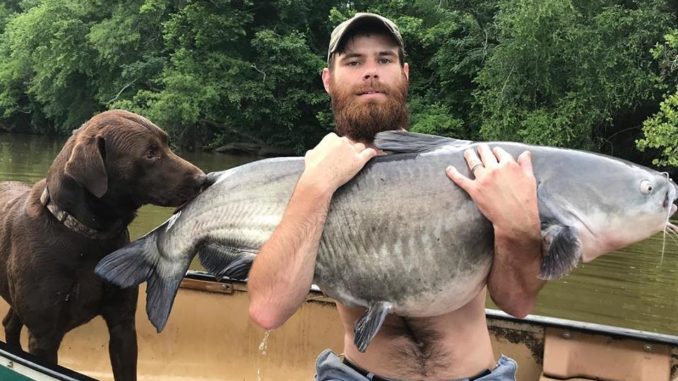
Fishing with jugs is an overlooked method for catching Mr. Whiskers
Catfish are popular species to fish for in the Carolinas, and anglers catch them with a variety of baits, techniques, and gear. Rods and reels are the most popular method, but it’s not the only way to put a hook in Mr. Whiskers.
Jugging is one of the lesser-used methods, but it can be just as effective — and fun — as any other way. It’s pretty much exactly what it sounds like: tying a line with a hook on the end to a jug, setting the jug afloat, then watching the jug drift until a catfish bites the hook.
James Crider of Anson County, N.C. said it’s one of his favorite ways to catch catfish on the Pee Dee River. He adds to the primitive nature of fishing this way by doing it from his canoe, and while making a recent jugging trip with friends Scott Forbes and Travis Horne, they landed a huge blue cat that looks to be 60 pounds or better.
“We didn’t have a scale, and even if we did, it wouldn’t have been possible to weigh it in the canoe. I’m not sure what it weighed. We just took a few photos and let it go, and I couldn’t have even caught it on my own. Scott and Travis were both a big help. Catching it was a team effort,” said Crider, who said this type of fishing is especially fun when kids are involved.
“It doesn’t take the same kind of patience as rod-and-reel fishing, and the kids don’t get bored as easily. You’re drifting along the river so it’s more interesting and fun for them to fish this way,” he said.
Crider, Forbes, and Horne were using gizzard shad as bait, and Crider said the water was about three feet high.
“Especially when the water is high, you want to drift in your canoe above the current of the jugs. That way if they get hung up on anything, you don’t have to fight the current to get back upstream to them. We vary the depths of our lines so that we cover a good range of the water column. Some lines are six feet long, and some are a foot long,” he said.
While Crider said catfish will bite in just about any section of the river, he said he especially likes areas that have some type of change to them. Any place the bottom turns from sand to mud is a good bet for drifting jugs. He also likes areas with sudden depth changes, and he said rocky areas can draw strikes too.
“Any time rocks are around, that’s good too, but you have to be more careful of the lines getting hung up,” he said.
Fishing with jugs is legal on the North Carolina section of the Pee Dee that Crider fishes, but it is not legal on South Carolina’s Great Pee Dee or Little Pee Dee Rivers. Not all bodies of water in the Carolinas allow it. South Carolina anglers can check the SCDNR regulation booklet, and North Carolina anglers can check the NCWRC regulations to see if their favorite water allows this type of fishing.




